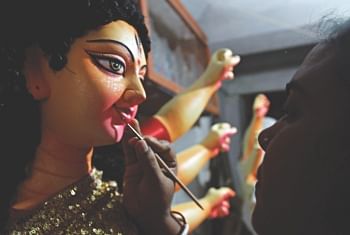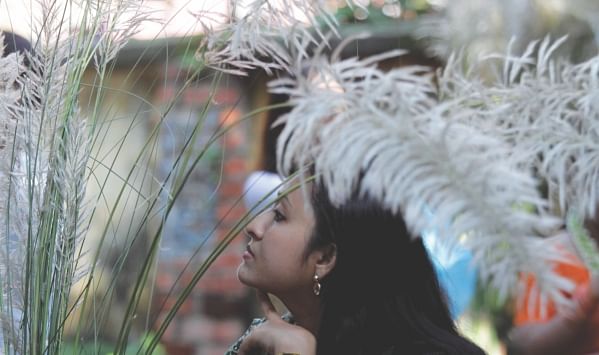| Home - Back Issues - The Team - Contact Us |
 |
| Volume 11 |Issue 41| October 19, 2012 | |
|
|
Perceptions Autumn Arrival Syed Maqsud Jamil Autumn has arrived. The heat has not gone but occasional relief brings ease. The monsoon is over, but the patter, the drizzle and downpour come and go. Two storms are marked to strike in the month of Aswin and Kartik. The land and its people live on with it. The nights are getting more or less tolerable.
Bhadra, Aswin, Kartik and Agrahayan as the months go autumn is among us. It is a subdued season to behold. Besides in what has become of the city the view outside the window is the window on the other side. It is not in autumn but in April the trees shed their leaves. Yet the autumn has arrived! When the mind is not burdened with cares, the eyes sometime lazily look up at the spectacular panorama of rain washed azure sky and discover bulbous and fluffy stretch of white cloud as though some painter drove on by a feisty creative spell has stroked his brush with great artistry. Saratkal or the early autumn sky is pristinely beautiful. Tagore celebrated it the most. Every season for him was a tale to be told. Satyajit Ray in his movie Pather Panchali has a memorable spectacle of autumn and innocence of childhood. It was Bibhutibhushan Bandapadhya's mastery of pastoral life and nature that endowed the description with great richness. The season was Saratkal and the flood plain was a stretch of swaying Kashphul (Kans grass); little Apu was running with his ever chirpy didi Durga through the abundance of Kashphul to catch a glimpse of the steam engine. In its aesthetic quality, it is a tribute to Saratkal. Famous Japanese film maker Akiro Kurosawa also used rain and clouds with great visual effect in his films. In internationally acclaimed film Rashomon, his use of rain was a treat to watch. When he made RAN the Japanese adaptation of King Lear he used the blue sky and the solitariness of the clumps of white clouds to highlight autumn and the failing strength of the old king after long campaign. Autumn is the month of festival for the Hindu community. The followers of the religion welcome it as the season of arrival of their greatest Goddess Durga. It is a festival they wait for and observe with boundless joy and merriment. For her followers Goddess Durga is durgatinashini (the one who brings the sufferings to an end). Monsoon and early autumn is a period of waiting with no work in the field, so the want is distressing. Durga comes as awakening and renewal. A festival of such importance naturally has great attraction. Most of the Puja Mandaps (where the deity is mounted) are put up in Shankhari Bazar, Tanti Bazar, Uttar Moisundi, Dakhkhin Moisundi, Bonogram, Joginagar, Bangla Bazar, Luxmi Bazar, Shonir Akhra and Rayer Bazar of old Dhaka and Siddheswari and Banani of new Dhaka. Water is considered the bounty of this land and water reaches the full mark during early autumn. Once this was the spectacle of the time particularly in the low lying areas of the land, when the paddy dancing in the breeze vied with the rising water to get its head out of it; the country boat skimmed through it. The paddy variety is no longer in favour and the water is not always bountiful. The engine has arrived and paddy is raised in standing water. The autumn of the time has changed.
Many that saw that time speak of taking the country boat to the village market. The swaying paddy touching the rim of the boat gladdened their hearts of a good harvest. The march of time has its own plan. Now they can watch their IRRI Borro field from the eaves of their tin shed or the straw hut. In recent years the flow of water reaching the high mark in autumn is not up to the expected level. Even chars (sandbanks) are not submerged; motor cycles venture into the chars. During autumn particularly during early autumn or Saratkal when water is up to the full mark the bigger fishes dip deeper into the water. Big fishes during autumn are difficult to catch and the supply has also gone down due to the loss of water reservoirs, wetlands and floodplains of rivers to the greed of land-grabbers. The land once surplus in big fishes has become dependent on imports from Paschimbanga. The smaller fishes like mola (Mola carpet), kakchi (Ganges river sprat), gura mach (assortment of small fishes), even koi(Climbing carpet) and sing (Stinging catfish)are easy to catch and are relatively in good supply during autumn. Smaller fishes with potato and with less curry are also a delicacy high in favour and also offer nutrition. Koi often climbs up to the mark when it is raining and is easy to catch. These are all time favourite fishes. And bless autumn for the smaller fishes. Fruits like tal (mangoesteen), kulboroi (jujube), peara (guava) and jambura (shaddoc) are available in autumn. Pancakes made of tal also are a popular delicacy. Peara is an adored fruit cut into slices and sprinkled with dried peppers and salt. Jamburas are in plentiful supply in autumn. The heat relents and the shadows lengthen during the day and the nights get unfailingly cooler with the onset of late autumn, kartik and agrahayan. It is a pleasant season. There is a mood of expectation. The winter vegetables start coming to the market from the later part of early autumn. Shim (Hyacinth pea)is an autumn vegetable closely followed by the arrival of cauliflower and cabbage. The dish with the first shim of the season is a welcome change of taste. In the later part of late autumn hemanta new rice is harvested. The granary has rice to celebrate nabanna. And the juice from date tree is collected in jars. Rice cakes soaked in date tree juice are a delicacy loved by all. Bhapa pitha (Rice cake) with molasses inside are popular all over the country. And Chitoi pitha is a ubiquitous item – these rice cakes are enjoyed throughout the winter but the flavor comes with the new rice. Autumn in this land is a season to persevere and to wait for the reward it brings. Bless be the autumn that has come.
|
||||
Copyright
(R) thedailystar.net 2012 |

